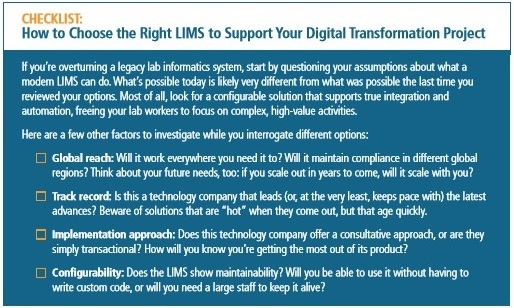What happens when a centuries-old international organization starts a digital innovation strategy?
The organization’s transformational strategy, now underway, hopes to create an eco-system that connects over 100 manufacturing plants and 15 R&D centers internationally.
A main goal of this company-wide strategy is to make laboratory data centralized within a corporate data lake so that researchers and different stakeholders can manipulate it by employing powerful AI and advanced analytics capabilities.
To attain this, the organization is adhering to several successful concepts of true digital transformation:
There Shall Be No ‘Big Bang’
The company has shaped their strategy of transformation into attainable phases, which removes any risks in the complete process by allowing for continuous improvement and learning.
Instead of interfacing all laboratory instruments to their new LIMS straight away for example, they selectively interfaced some of the high-volume instruments at a time, analyzed their effectiveness, and then adjusted the strategy as it developed.
Incrementally allowing their workforce to adapt to the change also helped in optimizing adoption of the new strategy.
Trust the Experts
The company approached this project from a student’s perspective. They enlisted the help of expert advisors. They sought to understand what was successful (or unsuccessful) in different transformational projects that had been previously launched.
The business maintained as much out-of-box (OOB) functionality as possible when adopting the new technology, which restricted customization activities and instead adjusted their process where necessary.
Commit to the Full Potential of Each Solution
When the organization looked at moments of connection between various functions again, they noticed that productivity was missing in the chasm between discrete solutions and tools.
For example, observe the handoff from R&D to QC. In the past, researchers utilized a standalone ELN to make their formulation ready prior to jumping to a LIMS interface to transport samples for testing.
This system weighed researchers down with unnecessary data entry tasks. It also separated that data between two systems which made complex analysis a requirement.
The introduction of LabVantage LIMS, which integrates R&D and QC activities with built-in ELN capabilities, changed this process.
The same LIMS also removes redundancies in the handoff to the manufacturing team, who can now gain access to the end formulation from the same interface. No more time is spent translating a paper process from R&D to adapt to the environment of production.
This organization’s LIMS system, a main element of their complete data transformation, hopes to connect over 15,000 users with each other going forward, enabling data transparency and insight from one edge of the organization’s international footprint to the other.
Identify the Right Technology
The next challenge is navigating a product landscape that is convulsing with innovation and change once the correct team has been selected with a transparent strategy in place.
A comprehensive understanding of the organization’s processes is required to identify which business technology will drive interconnectivity within an organization and add value overall.
The first step towards choosing the correct digital tools is logically mapping those processes based on the desired flow of data through an organization. Choosing technology to adapt to a legacy process may prevent an organization from achieving valuable and true transformation.
Instead, look at changing that paradigm. Processes should be redefined based on the available and best-in-class technology.
How LabVantage Helps to Strengthen Organization Ecosystems with a Highly Configurable OOB Solution
Companies with highly-customized or home-grown solutions, produced to suit a tailored operational process, frequently find themselves stuck in a mesh of technology that is difficult to update, scale or improve.
Heavy customization can also create compliance issues in laboratories, especially in the active and highly vigilant regulatory environment of the present day.
LabVantage assists organizations in removing those risks and understanding the potential of their digital transformation strategies by offering a LIMS that is very configurable and exclusively cloud-ready. In fact, LabVantage was the first in the market to provide a LIMS that is HTML5-compliant.
LabVantage LIMS is employed by its most successful customers as a driver for process change.
Instead of changing the OOB technology with customization, they adjust their processes to adapt to a technology created to assist the industry’s optimal and most efficient practices.
Purpose-built solutions are even supplied by LabVantage, offering laboratories dynamic access to LIMS functionality that is exclusive to their industry.
In this respect, laboratories are assured of consistent maintenance and regulatory compliance along with having the flexibility of a solution created to meet their exact requirements.

Image Credit: LabVantage Solutions

This information has been sourced, reviewed and adapted from materials provided by LabVantage Solutions, Inc.
For more information on this source, please visit LabVantage Solutions, Inc.